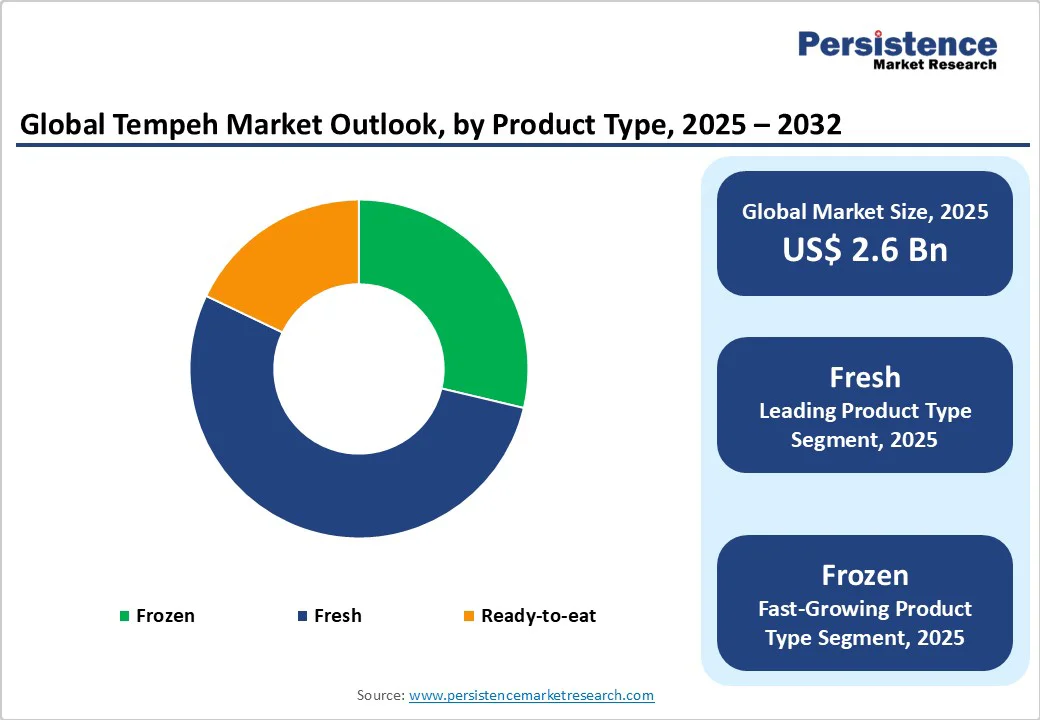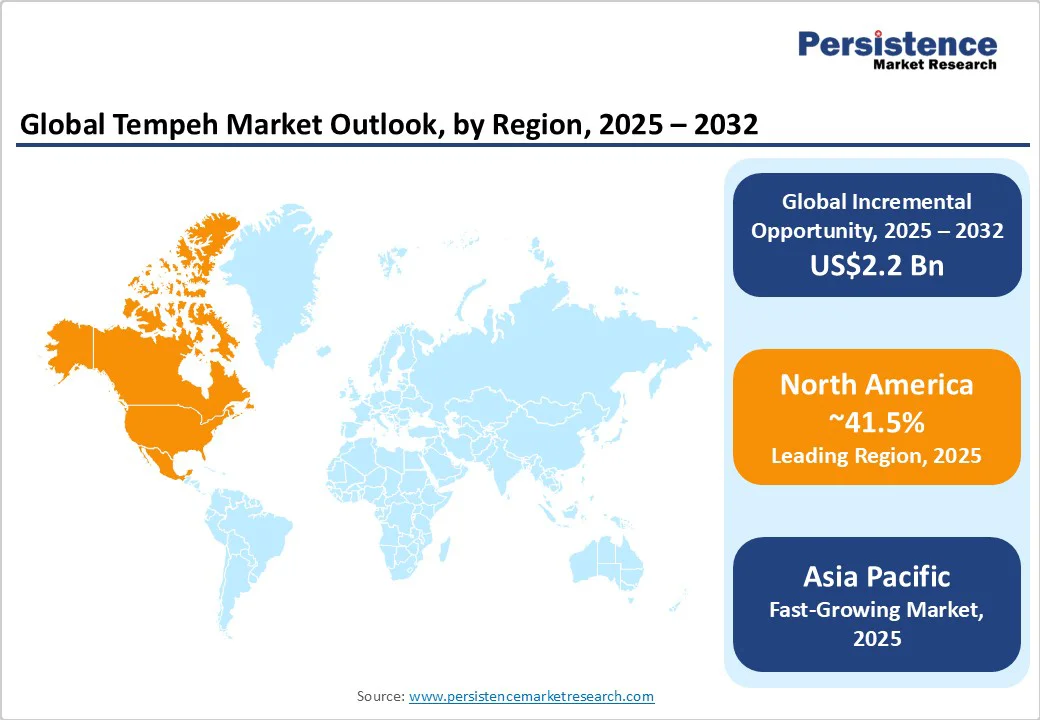ID: PMRREP23572| 191 Pages | 10 Oct 2025 | Format: PDF, Excel, PPT* | Food and Beverages

The global tempeh market size is expected to reach US$2.6 billion by 2025. It is estimated to reach US$4.8 billion by 2032, growing at a CAGR of 9.1% during the forecast period from 2025 to 2032, driven by a surge in plant-based eating, health-conscious lifestyles, and growing interest in fermented protein sources. The shift toward sustainable diets is also bolstering its acceptance worldwide.
| Key Insights | Details |
|---|---|
|
Tempeh Market Size (2025E) |
US$2.6 Bn |
|
Market Value Forecast (2032F) |
US$4.8 Bn |
|
Projected Growth (CAGR 2025 to 2032) |
9.1% |
|
Historical Market Growth (CAGR 2019 to 2024) |
8.4% |

The global shift toward plant-based diets is significantly boosting tempeh's popularity. Consumers are now seeking natural and minimally processed protein sources, moving away from ultra-processed meat substitutes. Tempeh, with its whole-food composition, aligns well with this trend, offering a nutritious alternative rich in protein, fiber, and probiotics.
In the U.K., for instance, brands such as Tiba Tempeh and Better Nature have reported impressive sales increases of 736% and 128%, respectively, in 2024. This indicates a growing consumer preference for whole-food, plant-based options.
Accessibility through Retail and Online Channels
The increased availability of tempeh in supermarkets and online platforms is contributing to its market growth. Retailers are expanding their product ranges to include tempeh, making it more accessible to a broader audience.
This expansion is driven by increasing consumer demand for convenient and healthy food options. For example, tempeh products are now widely available in leading grocery chains and online marketplaces, making it easy for consumers to access plant-based protein sources.
Fresh tempeh lasts only about 7 to 10 days under refrigeration, making transportation and retail display difficult without superior cold-chain infrastructure. In regions with unreliable refrigeration, spoilage, quality loss, and wastage are common.
Some innovations, including vacuum packing, freezing, and modified atmosphere packaging, can stretch shelf life. One study extended the duration to approximately 17 days with low-temperature storage and the addition of wheat flour. These methods are often costly and technically demanding, which limits their expansion for small producers.
In various parts of Africa, South America, and rural Asia, tempeh remains unfamiliar. Consumers may not recognize its taste, texture, or how to cook it, further creating a psychological barrier to trial. Marketing and advertising efforts are often weak or absent in these areas, resulting in poor communication of nutritional and sensory benefits.
In places where tofu or other plant proteins are already established, tempeh struggles to differentiate itself. Without better education, recipe integration, and accessible formats, many consumers remain hesitant to incorporate tempeh into their diets.
Emerging research indicates that tempeh, a fermented soy product, may provide functional health benefits for athletes and individuals with diabetes. Studies have shown that tempeh consumption can reduce creatine kinase levels and improve muscle strength recovery in athletes.
At the same time, tempeh's antioxidant properties may help reduce inflammation and oxidative stress, which are common concerns for athletes. For individuals with diabetes, tempeh has demonstrated potential in improving blood glucose control and reducing insulin resistance. The fermentation process enhances the bioavailability of nutrients in tempeh, making it a valuable addition to the diets of both athletes and individuals with diabetes seeking plant-based protein sources.
Developments in fermentation techniques are being explored to improve the texture and flavor of tempeh, addressing common consumer concerns. Innovations, such as the use of different microbial cultures and fermentation conditions, are being studied to enhance the sensory attributes of tempeh.
For instance, incorporating specific strains of Rhizopus oligosporus and adjusting fermentation parameters such as temperature and humidity can influence the texture and flavor profile of the final product. These developments aim to make tempeh more appealing to a broad audience, including those new to fermented foods, by enhancing its palatability and overall eating experience.
Fresh tempeh is estimated to account for approximately 53.4% of the market share in 2025, as it offers a flavor-rich and firm texture that many consumers associate with authenticity. Its fresh fermentation gives vibrant nutty, mushroomy notes, plus live cultures that contribute to its probiotic benefits. Fresh tempeh is also minimally processed, with no pasteurization or freezing to dull its aroma or degrade some volatile compounds. Hence, chefs and home cooks who prize sensory quality often opt for fresh products in dishes where texture and taste are paramount.
Frozen tempeh is gaining popularity as it solves important logistical and shelf-life constraints. It can be stored for a long time, shipped over long distances, and stocked in big inventories without spoilage. The expanding e-commerce and cold-chain infrastructure are also making frozen forms easily accessible, particularly in non-urban or non-traditional markets where sourcing fresh produce is challenging. Manufacturers are refining their freezing and packaging methods to preserve taste and texture, making frozen variants nearly as good as fresh in certain applications.
Soybeans are expected to account for a share of approximately 48.4% in 2025, as they are rich in complete protein and contain high levels of isoflavones, fiber, and minerals. Fermentation reduces compounds such as phytic acid and trypsin inhibitors, thereby improving the digestibility and bioavailability of nutrients. Soybeans are also abundant and cost-efficient in various tempeh-producing regions. Producers can reliably source soy of consistent quality, which supports uniform texture and flavor.
Adding grains to tempeh provides nutritional diversity. Grains bring complementary fibers, B-vitamins, and sometimes minerals that soy alone may have less of. For example, combinations such as soy and barley, soy and wheat, or soy and millet add different textures, flavors, and slow-digesting carbs. Multi-grain tempeh further appeals to consumers looking for novelty and functional food. It allows product differentiation. In India, start-ups are experimenting with tempeh blends to both cater to local tastes and enhance their nutrient profiles.
Retail will likely hold a share of nearly 67.2% in 2025, as it makes tempeh visible and accessible to consumers who may not be actively seeking it. When supermarkets shift tempeh from niche organic or health food aisles into main refrigerated protein sections, trial rates go up. Retail also allows providing small and consumer-friendly packages and flavored or seasoned variants that lower the barrier to first-time purchase. For example, flavored tempeh lines have captured roughly a fifth of retail sales in certain regions as of 2023.
Foodservice helps mainstream tempeh by integrating it into menus where people try new food items. Chains, cafés, and restaurants are incorporating tempeh into wraps, salads, bowls, and protein-centered items to capitalize on the demand for plant-based and fermented proteins. As foodservice buys in bulk, suppliers can expand formats such as crumbles or pre-seasoned blocks. It is projected to improve cost efficiencies and encourage development in texture or flavor suited for cooking at scale.

In 2025, North America is anticipated to account for approximately 41.5% of the market share, as tempeh has transitioned from niche-ethnic aisles to mainstream refrigerated protein shelves. The market is led by a few national brands that have made tempeh easily accessible to the average shopper. Lightlife, which is now part of Greenleaf/Maple Leaf Foods’ portfolio, is a key example. It claims the lion’s share of tempeh dollars and lists availability in thousands of retail locations. This has transformed tempeh from an ‘odd item’ to one that consumers can casually pick up while grocery shopping.
Product development is happening fast and in ways that matter to busy consumers. Bite-sized tempeh cubes, marinated ready-to-cook blocks, and protein crumbles that mimic the convenience of ground meat are now widely marketed. These formats enable chefs and home cooks to use tempeh exactly where they would use crumbled meat or cubed tofu. This removes preparation friction and widens the trial among people who would otherwise stick to tofu.
The Asia Pacific region represents both the traditional origin and the fastest-evolving market for tempeh, with contrasting trends across Southeast Asia and emerging Westernized markets, such as Australia, Japan, and China. In Indonesia, tempeh remains a national staple consumed daily by millions, with per capita intake among the highest for any plant-based protein. In Singapore, Thailand, and Malaysia, tempeh is transitioning from traditional wet markets to modern retail and restaurant menus, driven by the growing flexitarian and vegan consumer base.
Japan and South Korea are adapting tempeh through technological development. Japan-based firms, such as Marukome Co., have launched tempeh-based snacks and miso-tempeh hybrids, reflecting the country’s growing appetite for functional and fermented foods. Australia and New Zealand are emerging as hotspots for tempeh innovation and exports in the region. With the increasing popularity of plant-based diets, domestic brands, including Byron Bay Tempeh and Tempeh Meades, are utilizing non-GMO and organic soy to appeal to environmentally conscious consumers.
Europe has emerged as one of the most dynamic regions for tempeh innovation and commercialization, driven by the rise of veganism and the continent’s deep-rooted interest in fermented foods. The U.K., the Netherlands, and Germany are the key growth hubs, where consumers are seeking clean-label meat alternatives.
Plant Power and Better Nature Tempeh, two start-ups based in the U.K., have expanded their supermarket presence through partnerships with retailers, including Tesco and Sainsbury’s. These efforts are supported by public campaigns such as Veganuary, which recorded over 700,000 participants in 2024. In the Netherlands, De Hobbit and Bumi are developing multi-grain and lupin-based tempeh that caters to consumers with soy allergies.

The global tempeh market is characterized by a mix of established plant-based food companies and emerging regional producers. Key players include Tofurky Co., Lightlife Foods, Henry’s Tempeh Inc., and Smiling Hara Tempeh. These companies are expanding their product portfolios to cater to diverse consumer preferences. Strategic partnerships and collaborations are also facilitating entry into new geographic areas, broadening the reach of tempeh products to a global audience.
The tempeh market is projected to reach US$2.6 Billion in 2025.
Rising global preference for plant-based proteins and increasing adoption of flexitarian diets are the key market drivers.
The tempeh market is poised to witness a CAGR of 9.1% from 2025 to 2032.
Development of soy-free tempeh and collaboration with restaurants are the key market opportunities.
Maple Leaf Foods Inc., Nutrisoy Pty Ltd., and House Foods Group Inc. are a few key market players.
| Report Attribute | Details |
|---|---|
|
Historical Data/Actuals |
2019 - 2024 |
|
Forecast Period |
2025 - 2032 |
|
Market Analysis |
Value: US$ Bn |
|
Geographical Coverage |
|
|
Segmental Coverage |
|
|
Competitive Analysis |
|
|
Report Highlights |
|
By Product Type
By Source
By Distribution Channel
By Region
Delivery Timelines
For more information on this report and its delivery timelines please get in touch with our sales team.
About Author